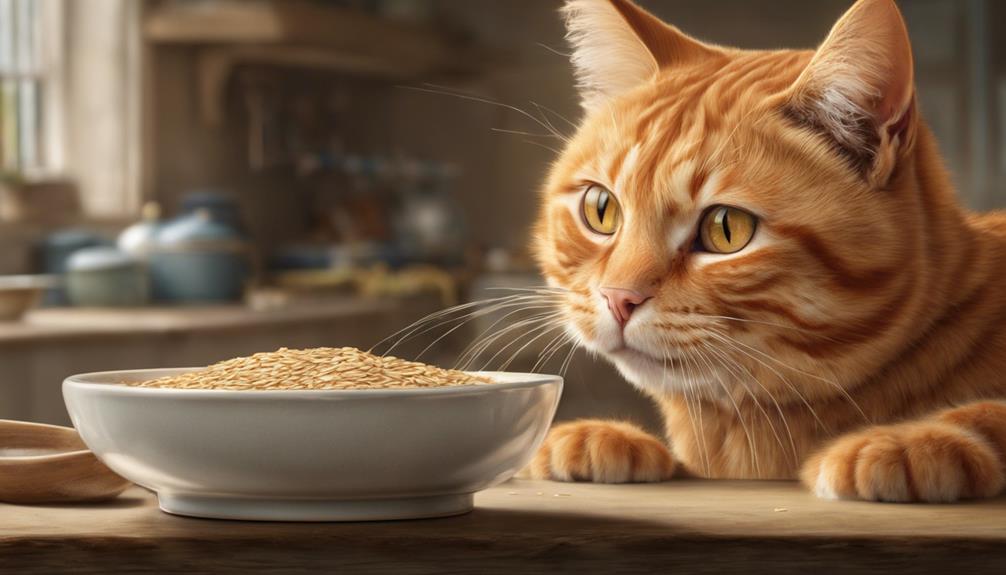Cats can eat oats safely as they offer essential nutrients such as fiber, antioxidants, and protein important for their overall health. Oats aid in digestion, prevent constipation, and support skin and coat health. Cats benefit from vitamins like B and minerals like iron found in oats. To feed oats, start slow, watch for negative reactions, and avoid flavored options. Oats in moderation as treats are ideal, but not a replacement for meat-based diets. Interested to discover more about how oats can positively impact your cat's diet and well-being?
Key Takeaways
- Oats are safe for cats in moderation.
- Monitor for any digestive issues when introducing oats.
- Cats can benefit from the fiber, vitamins, and minerals in oats.
- Plain oats are preferable over flavored options.
- Consult a vet before adding oats, especially for cats with dietary restrictions.
Benefits of Oats for Cats
Indisputably, cats can derive numerous benefits from incorporating oats into their diet. Oats provide a range of essential nutrients that contribute to the overall health and well-being of our feline friends. These fiber-rich foods play an important role in promoting digestive health for cats, aiding in proper digestion and preventing issues like constipation. Additionally, oats are a great source of antioxidants, protein, and calcium, all of which are significant for supporting your cat's immune system and bone health.
Moreover, the fatty acids found in oats can work wonders for your cat's skin and coat, helping to maintain a shiny, lustrous fur and healthy skin. Cats can also absorb essential vitamins and minerals like E and B vitamins, zinc, iron, and selenium from oats, further boosting their overall health. While oats may not be a necessary component of a cat's diet, incorporating them as an occasional treat can provide valuable nutritional benefits that contribute to your cat's health and vitality.
Nutritional Value of Oats

Oats offer a significant nutritional value for cats due to their high fiber content and essential vitamins and minerals. When considering the nutritional value of oats for cats, it's crucial to highlight the following:
- High in Protein: Oats contain a decent amount of protein, which is essential for cats to maintain muscle mass and overall health.
- Essential Amino Acids: Cats require specific amino acids in their diet for various bodily functions, and oats can provide some of these essential amino acids.
- Cats Can Eat Oatmeal: Oatmeal is a safe option for cats in moderation, providing a healthy treat alternative that's low in calories and rich in nutrients.
Oats as a Source of Fiber

When incorporating oats into a cat's diet, the added fiber content serves as a beneficial aid in promoting digestive health and overall well-being. The fiber in oats plays an essential role in regulating the digestive system of our feline friends.
Introducing oats in small amounts can be a wise choice to guarantee they receive the necessary fiber content. This fiber helps in maintaining regular bowel movements and can prevent issues like constipation in cats.
Additionally, the fiber content in oats can assist in making cats feel full and satisfied, which could potentially support weight management. For cats struggling with hairballs, the fiber in oats can be particularly helpful by aiding in the passage of hair through the digestive system.
Vitamins in Oats for Cats

Exploring the nutritional benefits of oats for cats reveals a range of essential vitamins that contribute to their overall health and well-being. Oats provide cats with a variety of vitamins, including:
- Vitamin B: Oats contain niacin, a type of vitamin B that's important for a cat's energy metabolism. This vitamin helps convert food into energy, supporting your feline friend's daily activities and vitality.
- Iron: Cats can benefit from the iron found in oats, as it plays a key role in the production of red blood cells. Adequate iron levels help make sure that your cat's body can transport oxygen effectively, supporting overall health and well-being.
- Selenium: The presence of selenium in oats contributes to a cat's antioxidant defense system and thyroid function. This essential mineral helps protect cells from damage and supports thyroid health, ensuring your cat's body functions optimally.
Incorporating oats into your cat's diet can provide them with these crucial vitamins and minerals, promoting their overall health and happiness.
Minerals Found in Oats

Oats are packed with essential minerals like manganese, phosphorus, and magnesium, which are vital for maintaining a cat's health. These minerals play key roles in supporting bone strength, energy production, muscle function, and overall well-being in cats.
Including oats in your feline friend's diet in moderation can provide them with these important nutrients for a healthy lifestyle.
Nutritional Benefits of Oats
Among the essential minerals found in oats are manganese, phosphorus, and magnesium, all of which play vital roles in supporting overall feline health. These minerals found in oats can benefit cats when consumed in moderation. Here are some key points about the minerals in oats:
- Manganese: Helps in bone formation and wound healing.
- Phosphorus: Essential for energy production and bone health.
- Magnesium: Plays a role in muscle function, nerve function, and protein synthesis.
When considering feeding your feline friend oatmeal, these minerals provide additional health benefits that can contribute to their overall well-being. It's crucial to maintain a balanced diet for your cat to optimize these benefits.
Importance of Minerals
Minerals found in oats, such as manganese, phosphorus, magnesium, and iron, are essential for supporting various bodily functions and promoting overall health in cats. These minerals are necessary for our feline friends' well-being, contributing to bone formation, energy production, metabolism, and oxygen transport in the blood. Here's a small table showcasing the importance of these minerals:
| Mineral | Function | Importance |
|---|---|---|
| Manganese | Bone formation and metabolism | Essential for overall health and well-being |
| Phosphorus | Energy production and bone health | Crucial for maintaining a healthy and active lifestyle |
| Magnesium | Nerve function and muscle health | Helps in supporting a strong and agile body |
| Iron | Oxygen transport and cell function | Necessary for a cat's vitality and overall function |
These minerals play a vital role in keeping our feline companions healthy and happy.
Oats for Cat Health
Nourishing our feline companions with a diet rich in essential minerals found in oats can greatly contribute to their overall health and well-being. Oats contain minerals like manganese, phosphorus, and magnesium that are crucial for cat health. Here are three key benefits of these minerals in oats for our beloved cats:
- Bone Health: Phosphorus supports strong bones and teeth in cats, keeping them active and agile.
- Energy Production: Manganese aids in collagen production, promoting healthy skin and fur in cats.
- Muscle Function: Magnesium helps regulate nerve and muscle function, ensuring our feline friends stay strong and mobile.
Incorporating oats into your cat's diet can provide these essential amino acids for their prime health.
Introduction of Oats to Cats
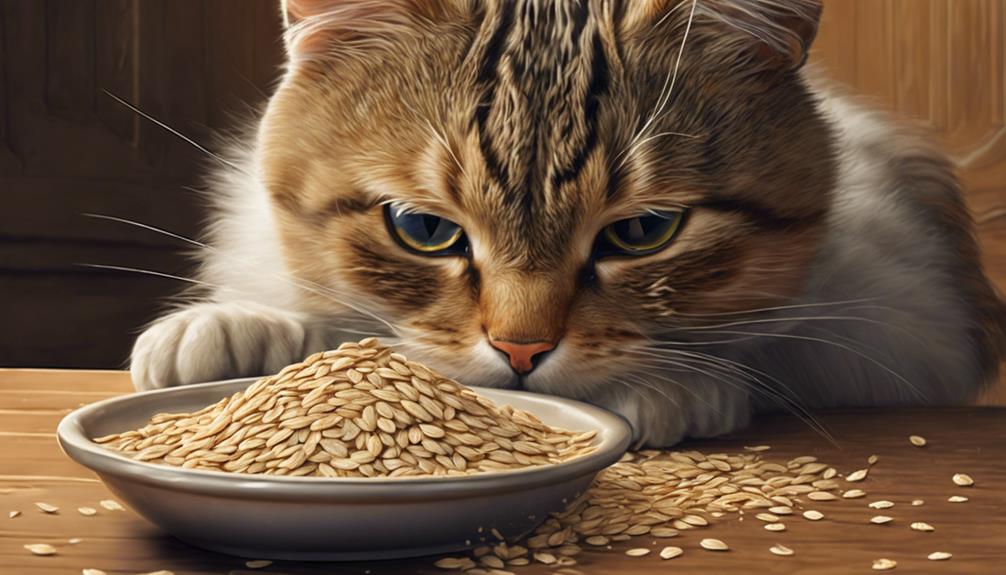
When introducing oats to cats, it's important to start with small amounts as an occasional treat to gauge their interest.
Some cats may not be keen on oats due to their preference for meat-based foods.
Serving oats plain without any added sugars or toppings is vital for their safety and enjoyment.
Oats for Cat Health
Introducing oats gradually into a cat's diet allows for careful monitoring of any digestive reactions. When considering oats for cat health, keep these points in mind:
- Start Slow: Begin by feeding cats small amounts of cooked plain oats, making sure they're well-tolerated.
- Monitor Closely: Watch for any signs of upset stomach, diarrhea, or other digestive issues when introducing oats to your cat.
- Consult a Vet: Before making oats a regular part of your cat's diet, speak with a veterinarian to confirm it aligns with their specific health needs.
Nutritional Benefits of Oats
Oats provide valuable nutritional benefits for cats, offering antioxidants, protein, and essential vitamins and minerals. These nutrients play a vital role in maintaining your feline friend's overall health and well-being.
Antioxidants found in oats help combat oxidative stress and boost the immune system, while the protein content supports muscle growth and repair. Additionally, oats contain vitamins such as vitamin E and B, along with minerals like zinc, iron, and selenium, which are essential for various bodily functions in cats.
Compared to other grains like rice and wheat, oats have a higher protein content, making them a nutritious addition to your cat's diet. Remember, moderation is key when introducing oats to your cat to ensure a balanced and healthy diet.
Risks of Feeding Oats
While cats can benefit from the nutritional value of oats, it's important to be aware of potential risks associated with introducing this grain into their diet. When considering feeding oats to your feline friend, remember the following:
- Start Slow: Introduce oats gradually to watch for any digestive problems that may arise.
- Limit Amounts: Offer oats as an occasional treat in a small amount to prevent overwhelming your cat's system.
- Monitor Response: Keep an eye on your cat's reaction to oats; some cats may not enjoy the taste due to their natural carnivorous preferences.
Monitoring Cats Reaction to Oats
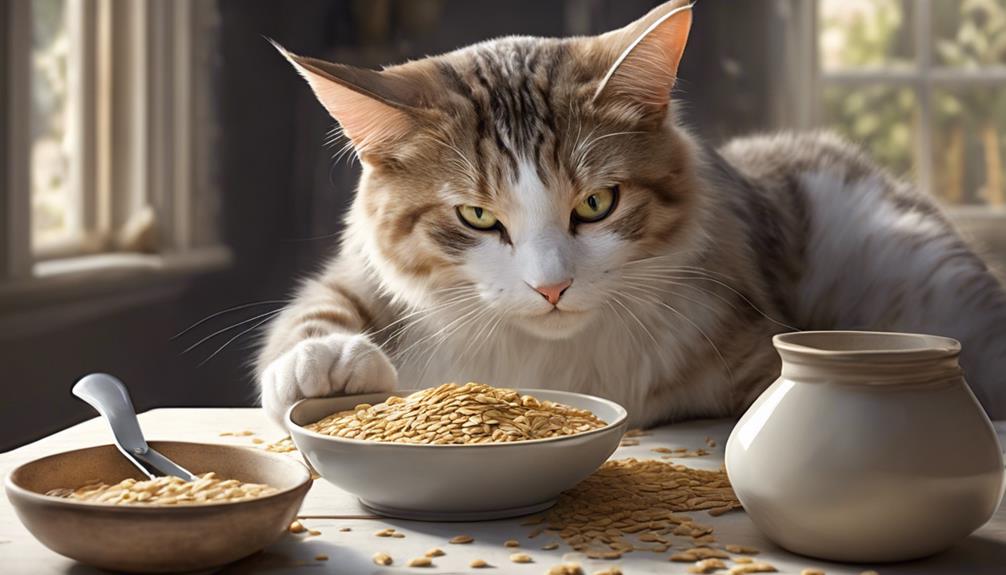
If a cat shows any signs of gastrointestinal upset or allergic reactions after consuming oats, it's important to promptly seek veterinary advice.
Watching for digestive issues like vomiting or diarrhea, monitoring for allergic reactions such as itching or swelling, and being observant of any changes in stool consistency or litter box habits are vital when introducing oats to your cat's diet.
Additionally, pay attention to your cat's behavior, appetite, and energy levels after incorporating oats into their meals. Any negative reactions or concerns should be noted and discussed with your veterinarian to guarantee your cat's health and well-being.
By keeping a close eye on how your feline friend responds to oats, you can quickly address any potential issues and make informed decisions about their diet.
Precautions When Feeding Cats Oats

When integrating oats into a cat's diet, it's important to take specific precautions to ensure their well-being and digestive health.
- Serve Plain Oats: Cats should only consume plain oats without added toppings like sugar or cinnamon to prevent digestive issues.
- Mix with Wet Food: Cats mightn't be enthusiastic to eat oats alone, so mixing them with wet cat foods can make them more appealing and palatable.
- Offer in Small Quantities: It's essential to give cats oats in small portions as an occasional treat to prevent nutrient imbalances in their diet.
Following these precautions will help maintain your cat's health and well-being. Remember, oats aren't a necessary component of a cat's diet and shouldn't replace their regular meat-based cat foods, which provide essential amino acids vital for their overall health.
Consult your veterinarian before introducing oats to your cat, especially if they've gastrointestinal issues or specific dietary restrictions. Your furry companion's health is a top priority, so take these precautions seriously when incorporating oats into their diet.
Plain Oats Vs. Flavored Oats

When it comes to feeding cats oats, it's vital to distinguish between plain and flavored varieties. Plain oats contain no harmful additives, making them a safer option for feline consumption.
Flavored oats, however, may introduce unwanted ingredients like sugar or artificial flavors that could potentially upset a cat's digestive system.
Plain Vs. Flavored Oats
Comparing plain oats to flavored oats reveals significant differences in their suitability for cats' consumption. Here's why we recommend sticking to plain oats for your feline friend:
- Nutritional Value: Plain oats offer essential nutrients without added sugars that can harm your cat's health.
- Sugar Content: Flavored oats often contain high sugar levels, contributing to obesity and dental issues in cats.
- Healthier Option: Opting for plain oats guarantees your cat enjoys a wholesome snack without any unnecessary additives.
Nutritional Value Comparison
For a cat's peak health, choosing plain oats over flavored varieties is crucial due to their superior nutritional value. Plain oats are rich in essential nutrients like fiber, vitamins, and minerals, making them a safe food choice for cats.
On the other hand, flavored oats can be high in calories and may contain unhealthy additives that aren't advantageous for feline diets. By opting for plain oats, cats can enjoy a nutritious treat without the potential harm from added sugars and artificial ingredients.
It's important to prioritize the well-being of our furry friends by selecting foods that support their overall health. Hence, when considering oats for cats, plain varieties are the way to go to guarantee they receive the best nutritional benefits without compromising their well-being.
Health Considerations for Cats
To guarantee the well-being of our feline friends, prioritizing plain oats over flavored varieties is key when considering their health needs. When it comes to the health considerations for cats, here are the essential points to remember:
- Obligate Carnivores: Cats are obligate carnivores, meaning their diet should primarily consist of animal-based proteins. While oats can offer some nutritional benefits, they shouldn't replace meat in their diet.
- Linoleic Acid: Plain oats contain linoleic acid, an essential omega-6 fatty acid important for maintaining healthy skin and coat in cats. Flavored oats may lack this essential nutrient.
- Avoid Additives: Flavored oats often contain sugar and artificial flavors that can be harmful to cats. Stick to plain oats to guarantee their safety and well-being.
Oats in Commercial Cat Foods
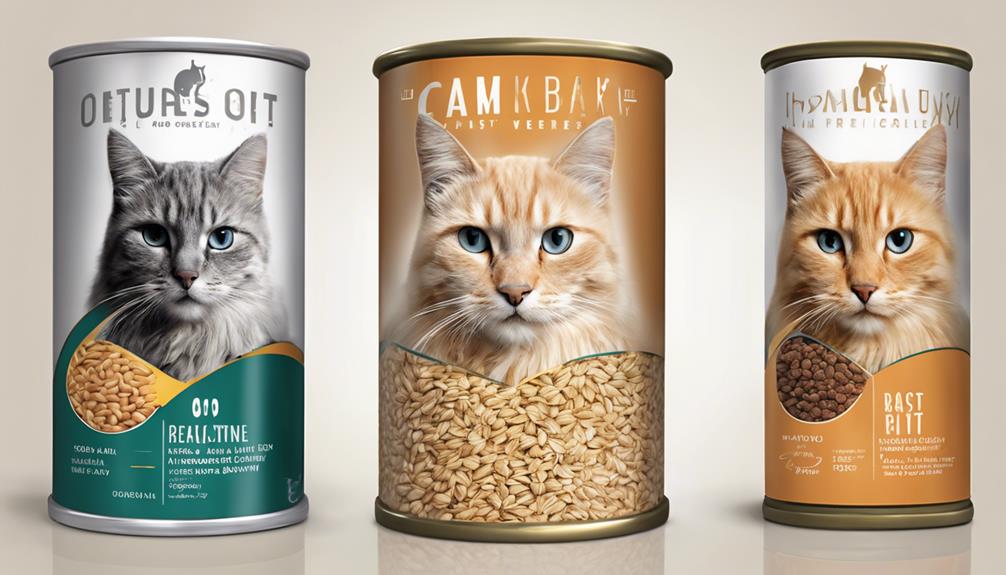
In some commercial cat foods, oats are strategically incorporated to enhance the fiber content and provide essential nutrients for feline health. These oats can play a vital role in supporting digestive health and regulating bowel movements for our beloved furry companions.
The inclusion of oats in commercial cat foods not only boosts the nutritional benefits but also adds a tasty and textured element that some cats truly enjoy. By choosing cat foods with oats, we can offer our feline friends a diverse range of nutrients and flavors to keep their diets interesting and balanced.
Additionally, these oat-infused cat foods may contain added vitamins and minerals that contribute to overall well-being. So, next time you're browsing the pet food aisle, consider picking up a bag of commercial cat food with oats to provide your cat with a wholesome and satisfying meal that caters to their digestive needs and taste preferences.
Oats as an Occasional Treat
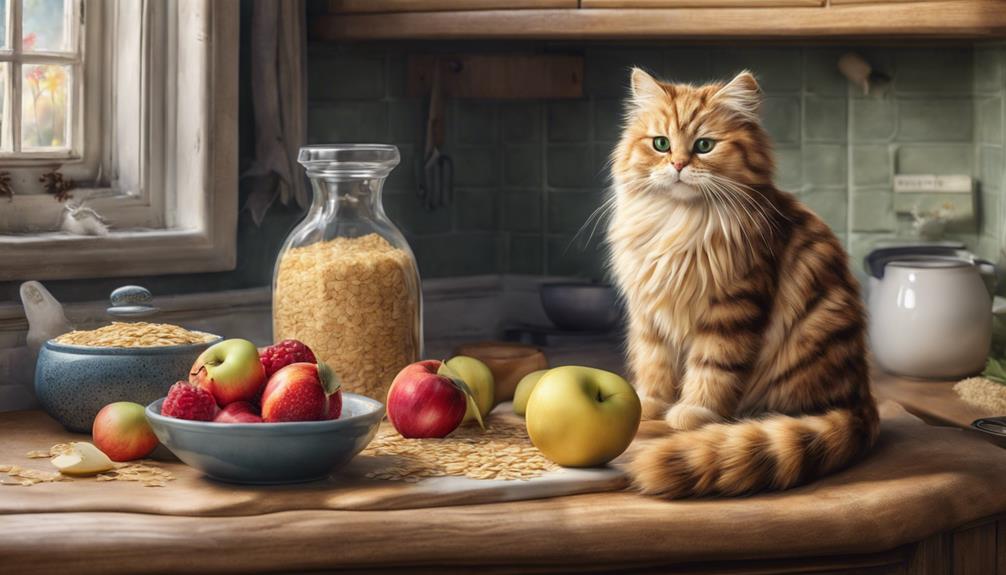
As pet owners, we can offer oats to our cats as an occasional treat, ensuring moderation to prevent any potential dietary imbalances. When considering adding oats to your cats' diet, keep these points in mind:
- Supplemental Nature: Oats aren't essential for a cat's diet but can be given as an occasional treat to provide variety.
- Moderation is Key: Feed oatmeal in small amounts to prevent any nutritional imbalances since cats have specific dietary requirements.
- Beneficial Fatty Acids: Oats contain beneficial fatty acids that can be a healthy addition to your cat's diet, but they shouldn't replace their regular food.
Homemade Oat Treats for Cats

Mixing cooked oats with a small amount of wet cat food creates homemade oat treats that can be a delightful and healthy snack for your feline friend. When preparing these homemade oat treats, it's crucial to utilize water rather than milk to guarantee it's safe for your cat's digestion. Oats are rich in beneficial nutrients like linoleic acid and amino acids, making them a fantastic addition to your cat's diet when prepared correctly.
After combining the oats and wet cat food, molding the mixture into small balls or treat shapes can simplify feeding. Bake the treats in the oven at a low temperature until they're solid and slightly crispy. Once they're finished, allow the treats to cool completely before presenting them to your cat. These homemade oat treats offer a different texture and flavor that your cat may appreciate as an occasional snack.
Oats Vs. Other Human Foods for Cats

Why are oats a better choice for cats compared to other human foods?
When it comes to providing our feline friends with a treat, oats stand out for several reasons:
- Nutritional Value: Oats offer a good amount of fiber, vitamins, and minerals that cats need to stay healthy. This makes oatmeal a good option for supplementing their diet without compromising their nutritional needs.
- Safety: Unlike some other human foods that can be harmful to cats, oatmeal is generally safe for them to eat. This means you can feel confident about giving your cat a bit of oatmeal as an occasional snack.
- Health Benefits: Incorporating oats into your cat's diet can have positive effects on their digestion and overall well-being. Cats need a balanced diet, and oats can contribute to that balance when given in moderation.
Considering these factors, oats emerge as a favorable choice when it comes to treating your cat with human food.
Cat-Friendly Oat Recipes

Let's explore some delicious oat recipes that are safe and enjoyable for cats to try. Cats can have oats as a part of their diet, and incorporating them into homemade treats can be a fun way to provide some variety. Remember, oats should only be given to cats as an occasional treat, as they are not essential in a regular cat's diet. Avoid flavors like sugar or salt that can be harmful to your feline friend. Here are a couple of cat-friendly oat recipes that you can try:
| Recipe | Ingredients |
|---|---|
| Oat Wet Food | Cooked plain oats, wet cat food |
| Oatmeal Treats | Rolled oats, wet cat food, water |
These recipes are simple and easy to make. Just make sure that the oats are well-cooked and mixed thoroughly with the wet food. Your cat will appreciate the change in taste and texture, making treat time even more enjoyable!
Oats in a Cats Balanced Diet

While oats can be safely consumed by cats as an occasional treat, they aren't a necessary component of a cat's balanced diet due to their carnivorous nature. Cats have specific dietary requirements that are best met through their usual cat food, which is protein-rich and tailored to their carnivorous needs.
When considering oats in a cat's diet, it's important to understand that:
- Cats need to eat protein-heavy diets: Their bodies are designed to thrive on animal-based proteins, and oats don't provide the essential nutrients that cats require for peak health.
- Avoid oatmeal as a primary food source: While oats can be given as a rare treat, they shouldn't replace the meat-based foods that are essential for a cat's well-being.
- Cats may not show enthusiasm for oats: Due to their preference for meaty and fishy flavors, cats may not be as interested in consuming oats regularly.
Frequently Asked Questions
Is It Safe for Cats to Eat Oats?
Eating oats can be safe for cats in moderation. They can enjoy the benefits of fiber, protein, and vitamins. Always consult our vet before adding oats to a feline diet. Too much may cause digestive problems.
Can Cats Eat Oatmeal and Rice?
We can give cats oatmeal and rice as occasional treats in moderation. These foods can provide fiber and protein. It's important to remember they should not replace a cat's regular diet. Always consult a vet first.
Can Cats Eat Granola Oats?
We recommend avoiding granola oats for cats due to potential digestive issues. Stick to plain oats as an occasional treat. It's important to check ingredients and prioritize your cat's health by opting for less processed options.
What Human Foods Are Safe for Cats?
Understanding their dietary needs is essential. Some foods like plain oats are beneficial in moderation. Avoid additives like sugar or milk. Always prioritize your feline friend's well-being.
Should I Be Concerned About Feeding My Cat Oats If They Can Eat Cereal Safely?
If you’re wondering about cats and cereal consumption, it’s best to avoid feeding them oats or any other cereal. While some may tolerate it, it’s not ideal for their diet. Stick to specially formulated cat food to ensure they get the nutrients they need.
Conclusion
To sum up, oats can be a safe and beneficial addition to your cat's diet. With their high fiber content, vitamins, and minerals, oats offer a nutritious boost for your feline friend.
By incorporating oats into homemade treats or cat-friendly recipes, you can provide a healthy snack that your cat will love. Remember, moderation is key when introducing new foods to your pet's diet.
So why not treat your cat to some oats and watch them purr with delight!
